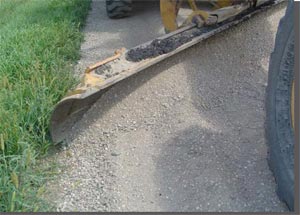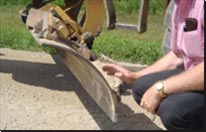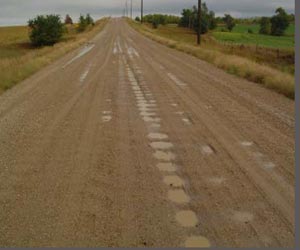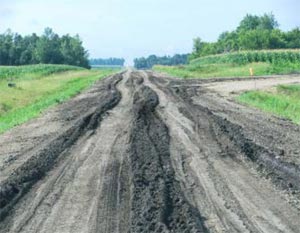| 1. |
Which one of the following are the basics of a gravel road?
- A crowned driving surface,
- A shoulder area that slopes directly away from the edge of the driving surface, and
- A ditch.
|
|
|
1 and 2 |
|
|
1 and 3 |
|
|
1,2, and 3 |
| 2. |
The space for the shoulder area and the ditch of many gravel roads is often_______. This is particularly true in regions with very narrow or confined rights-of-way. |
|
|
Minimal |
|
|
Maximal |
| 3. |
Operating speed in blading operations must not be excessive. It is virtually impossible to do good work above a top speed of |
|
|
3 to 5 mph in most conditions. |
|
|
10 to 15 mph in most conditions. |
| 4. |
The angle of the moldboard is also critical for good maintenance.This angle is fixed on some grading devices, but on motor graders it can be easily adjusted.It is important to keep the angle somewhere between 30 and 45 degrees as illustrated in Figure2.

|
|
|
30 and 45 degrees |
|
|
45 and 60 degrees |
| 5. |
Along with correct angle, it is important to understand proper pitch or "tilt" of a moldboard. If the moldboard is pitched back too far, the material will tend to build up in front of the moldboard and will not fall forward and move along to the discharge end, or heel, of the blade. This also causes excess material loss from the toe of the moldboard.It also reduces the mixing action that is desirable when recovering material from the shoulder and moving it across the roadway, leveling and smoothing it in the process. This mixing action is part of routine maintenance.
 |
|
|
True |
|
|
False |
| 6. |
In some areas, particularly arid or semi-arid regions, it is a commonly accepted practice to leave a small maintenance windrow near the edge of the roadway. The windrow left in this picture is:
 |
|
|
Appropriate amount |
|
|
Excessive amount |
| 7. |
How much crown is enough? Problems develop quickly when a gravel road has no crown. A proper crown ensures water will drain off the roadway surface during a rain event. Without it, water will quickly collect on the road surface during a rain event or snow melt and will soften the crust. Water retained in the roadway surface can lead to rutting, which can extend down into the subgrade.Therefore, a properly drained gravel road must have a sufficient or adequate crown.
The road in the is picture has

|
|
|
Enough crown |
|
|
Lacks adequate crown |
| 8. |
The road shoulder serves several essential functions. Primarily, its up ports the edge of the traveled portion of the roadway. Another important function is to provide a safety area for drivers to regain control of vehicles, if forced to leave the road surface. The shoulder also plays an important role in drainage, carrying water further away from the road surface towards the fore slope and into the ditch. |
|
|
True |
|
|
False |
| 9. |
Gravel roads are generally maintained by routine blading and adding gravel as needed by |
|
|
spot graveling |
|
|
re-graveling entire sections. |
|
|
Both above |
| 10. |
Reshaping surface and shoulder can usually be corrected with the motor grader alone. __________ is the best time for this work as there is minimal vegetative growth and moisture is often present. There shaping of the driving surface and the road shoulder can be done by cutting material with the motor grader and relaying it to the proper shape and crown. |
|
|
Spring |
|
|
Summer |
|
|
Autumn |
| 11. |
Which one of the following techniques could be helpful with erosion when reshaping a gravel road
- Pay attention to the seasons. Some regions have certain times in the year when frequent and heavy rainfall can be expected. Try to avoid major reshape work during those time periods.
- Keep disturbed areas as small as possible. The more earth you disturb, the greater will be the risk of soil erosion.Set work boundaries and don’t let work crews get outside of them
- Consider stabilization of disturbed areas. Seeding, mulching, erosion control blanket sand other methods as applicable can be used effectively.
- Keep water velocities low. Removing vegetative cover generally increases the volume and velocity of water runoff.Keep slopes as shallow or gentle as possible.Keep ditch slope as gentle as possible. Shorten drainage runs and work to get vegetative cover reestablished as soon as possible after work is finished
- Keep sediment within work boundaries. Sediment can be retained by filtering water as it flows (as through a silt fence), and ditch checks will retain dirty runoff water for a period of time until particles of sediment settle out.
- Inspect recent work. It is vital to make sure channels haven’t formed in ditch bottoms or on slopes, or around and under controls that we reused. Be particularly vigilant after heavy rain events.
|
|
|
a and b |
|
|
a, b, and e |
|
|
All above |
| 12. |
In intersection of the gravel road with a paved road the rule is always the same. Eliminate crown ________ from the edge of the paved road. |
|
|
100 feet |
|
|
200 feet |
|
|
300 feet. |
| 13. |
Bridge approaches, the rule for shaping a bridge approach is always the same. Approximately 100 feet from the bridge, begin to gradually take the crown out of the gravel road so that you can match the bridge deck as closely as possible. Potholes can easily form at the edge of the deck. Cut them out and fill them, but don’t push gravel onto the deck. |
|
|
100 feet |
|
|
200 feet |
|
|
300 feet |
| 14. |
In railroad crossings; Always begin to eliminate the crown approximately 100 feet away and shape the road to match the crossing. Of special consideration is to be extremely careful about keeping gravel out of the flangeways along the rails. This can cause a derailment, particularly when it combines with snow pack and frozen material in cold climates. Also, be extremely careful not to strike the rails themselves. |
|
|
True |
|
|
False |
| 15. |
In roadway preparation; when fresh gravel is to be placed on a road, it is vital to properly shape the road surface first. For example the road in the picture has been damaged by heavy hauls of the past. Reshaping of the whole road is required before new gravel is placed on top of it.
 |
|
|
True |
|
|
False |
|